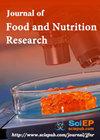含益生菌的发酵大豆咖啡布丁:产品配方和发酵过程中成分变化的评估
IF 0.6
4区 农林科学
Q4 FOOD SCIENCE & TECHNOLOGY
引用次数: 0
摘要
本研究旨在开发一种以咖啡和大豆壳为原料的益生菌发酵豆浆甜点。用10%粉状豆浆(w/v)、不同百分比的糖、阿拉比卡可溶性咖啡和大豆壳配制了9种发酵配方。用乳酸杆菌和双歧杆菌益生菌(10 6 CFU/mL)进行发酵。来自巴西里约热内卢和库里蒂巴的129名成年人对配方产品的接受度进行了评估。最后的配方进行了物理化学表征。发酵6h时,两菌株的益生菌数量均由106个增加到108个。广为接受的配方含有15%的蔗糖,1%的大豆壳和0.5%或1.5%的可溶性咖啡(在9分制中得分:6.6±1.5)。另外,蔗糖也可以用其他类型的甜味剂代替。每天喝2-4杯咖啡的年轻人(n=45)最喜欢该产品(得分:7.1±1.4)。发酵不影响总大豆异黄酮含量,但使咖啡绿原酸含量降低32.6%,代谢产物为生物可利用的酚酸。产生胀气的低聚糖含量也有所下降。综上所述,益生菌发酵和阿拉比卡可溶性咖啡的添加使开发一种被广泛接受且潜在健康的无豆味、无乳、布丁状甜点成为可能。本文章由计算机程序翻译,如有差异,请以英文原文为准。
Fermented Soy-coffee Pudding Dessert Containing Probiotics: Product Formulation and Evaluation of Compositional Changes during Fermentation
This study aimed at developing a probiotic fermented soymilk-based dessert containing coffee and soybean hull. Nine fermented formulations were elaborated with 10% powdered soymilk (w/v), varying percentages of sugar, arabica soluble coffee, and soy hull. They were fermented with probiotic strains of Lactobacilli and Bifidobacteria (10 6 CFU/mL). One hundred and twenty-nine adults from Rio de Janeiro/RJ and Curitiba/PR, Brazil, evaluated the acceptance of the formulated products. The final formulation was physicochemically characterized. During 6h fermentation, the probiotics count increased from 10 6 to 10 8 in both strains. The well-accepted formulation contained 15% sucrose, 1% soy hull, and 0.5 or 1.5 % soluble coffee (score: 6.6±1.5 on a 9-point-scale). Alternatively, sucrose can be replaced by other types of sweeteners. Young people (n=45) who drank 2-4 cups of coffee per day liked the product the most (score: 7.1±1.4). While fermentation did not affect the total soy isoflavones content, it decreased the content of coffee chlorogenic acids by 32.6% but produced bioavailable phenolic acids as metabolites. A decrease in the content of flatus-producing oligosaccharides was also observed. In conclusion, probiotics fermentation and the addition of arabica soluble coffee made possible the development of a well-accepted and potentially healthy beany-flavor-free, dairy-free, pudding-like dessert.
求助全文
通过发布文献求助,成功后即可免费获取论文全文。
去求助
来源期刊

Journal of Food and Nutrition Research
农林科学-食品科技
CiteScore
1.60
自引率
9.10%
发文量
0
审稿时长
1 months
期刊介绍:
Journal of Food and Nutrition Research (JFNR) publishes papers focusing on fundamental and applied research in chemistry, physics, microbiology, nutrition aspects, bioactivity, quality, safety, and technology of foods.
 求助内容:
求助内容: 应助结果提醒方式:
应助结果提醒方式:


